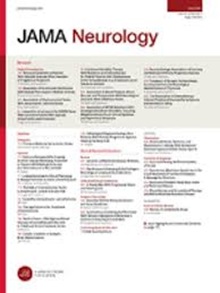Antiseizure Medications for Adults With Epilepsy: A Review.
IF 21.3
1区 医学
Q1 CLINICAL NEUROLOGY
引用次数: 69
Abstract
Importance Epilepsy affects approximately 65 million people worldwide. Persistent seizures are associated with a 20% to 40% risk of bodily injuries (eg, fractures, burns, concussions) over 12-month follow-up. The primary goal of epilepsy treatment is to eliminate seizures while minimizing adverse effects of antiseizure drugs (ASDs). Observations An epileptic seizure is defined as a sudden occurrence of transient signs and symptoms caused by abnormal and excessive or synchronous neuronal activity in the brain. Focal and generalized epilepsy are the 2 most frequent types of epilepsy; diagnosis is based on the type of seizures. There are 26 US Food and Drug Administration-approved medications for epilepsy, of which 24 have similar antiseizure efficacy for focal epilepsy and 9 have similar efficacy for generalized epilepsy. The decision to initiate an ASD should be individualized, but should be strongly considered after 2 unprovoked seizures or after 1 unprovoked seizure that occurred during sleep and/or in the presence of epileptiform activity on an electroencephalogram and/or in the presence of a structural lesion on the brain magnetic resonance imaging. The ASDs must be selected based on the seizure and epilepsy types, the epilepsy syndrome, and the adverse effects associated with the drug. For focal epilepsy, oxcarbazepine and lamotrigine are first-line therapy, while levetiracetam can be also considered if there is no history of psychiatric disorder. For generalized epilepsy, the selection of the ASD is based on the type of epilepsy syndrome and the patient's sex, age, and psychiatric history. Seizure freedom is achieved in approximately 60% to 70% of all patients. A total of 25% to 50% of patients also experience neurologic, psychiatric, cognitive, or medical disorders, such as mood, anxiety, and attention deficit disorders and migraines. For these patients, selecting an ASD should consider the presence of these disorders and concomitant use of medications to treat them. ASDs with cytochrome P450 enzyme-inducing properties (eg, carbamazepine, phenytoin) may worsen comorbid coronary and cerebrovascular disease by causing hyperlipidemia and accelerating the metabolism of concomitant drugs used for their treatment. They can also facilitate the development of osteopenia and osteoporosis. Conclusions and Relevance Epilepsy affects approximately 65 million people worldwide and is associated with increased rates of bodily injuries and mortality when not optimally treated. For focal and generalized epilepsy, selection of ASDs should consider the seizure and epilepsy types and epilepsy syndrome, as well as the patient's age and sex, comorbidities, and potential drug interactions.成人癫痫患者抗癫痫药物研究综述
癫痫影响全球约6500万人。在12个月的随访中,持续癫痫发作与20%至40%的身体损伤(如骨折、烧伤、脑震荡)风险相关。癫痫治疗的主要目标是消除癫痫发作,同时尽量减少抗癫痫药物(ASDs)的不良反应。观察癫痫发作的定义是由大脑中异常、过度或同步的神经元活动引起的短暂性体征和症状的突然发生。局灶性癫痫和全身性癫痫是两种最常见的癫痫类型;诊断是基于癫痫发作的类型。美国食品和药物管理局批准了26种治疗癫痫的药物,其中24种对局灶性癫痫具有类似的抗癫痫疗效,9种对全面性癫痫具有类似的疗效。启动ASD的决定应个体化,但应强烈考虑在2次非诱发性癫痫发作或1次非诱发性癫痫发作发生在睡眠和/或在脑电图上出现癫痫样活动和/或在脑磁共振成像上出现结构性病变。必须根据癫痫发作和癫痫类型、癫痫综合征以及与药物相关的不良反应来选择自闭症谱系障碍。对于局灶性癫痫,奥卡西平和拉莫三嗪是一线治疗,如果没有精神疾病史,也可以考虑使用左乙拉西坦。对于全身性癫痫,ASD的选择是基于癫痫综合征的类型和患者的性别、年龄和精神病史。大约60%至70%的患者实现了癫痫发作自由。总共有25%至50%的患者还会出现神经、精神、认知或医学障碍,如情绪、焦虑、注意力缺陷障碍和偏头痛。对于这些患者,选择ASD应该考虑这些障碍的存在和伴随的药物治疗。具有细胞色素P450酶诱导特性的asd(如卡马西平、苯妥英)可能通过引起高脂血症和加速用于治疗的伴随药物的代谢而加重合并的冠状动脉和脑血管疾病。它们还可以促进骨质减少和骨质疏松症的发展。全世界约有6500万人患有癫痫,如果得不到最佳治疗,癫痫会增加身体伤害和死亡率。对于局灶性和全身性癫痫,asd的选择应考虑发作和癫痫类型和癫痫综合征,以及患者的年龄和性别、合并症和潜在的药物相互作用。
本文章由计算机程序翻译,如有差异,请以英文原文为准。
求助全文
约1分钟内获得全文
求助全文
来源期刊

JAMA neurology
CLINICAL NEUROLOGY-
CiteScore
41.90
自引率
1.70%
发文量
250
期刊介绍:
JAMA Neurology is an international peer-reviewed journal for physicians caring for people with neurologic disorders and those interested in the structure and function of the normal and diseased nervous system. The Archives of Neurology & Psychiatry began publication in 1919 and, in 1959, became 2 separate journals: Archives of Neurology and Archives of General Psychiatry. In 2013, their names changed to JAMA Neurology and JAMA Psychiatry, respectively. JAMA Neurology is a member of the JAMA Network, a consortium of peer-reviewed, general medical and specialty publications.
 求助内容:
求助内容: 应助结果提醒方式:
应助结果提醒方式:


